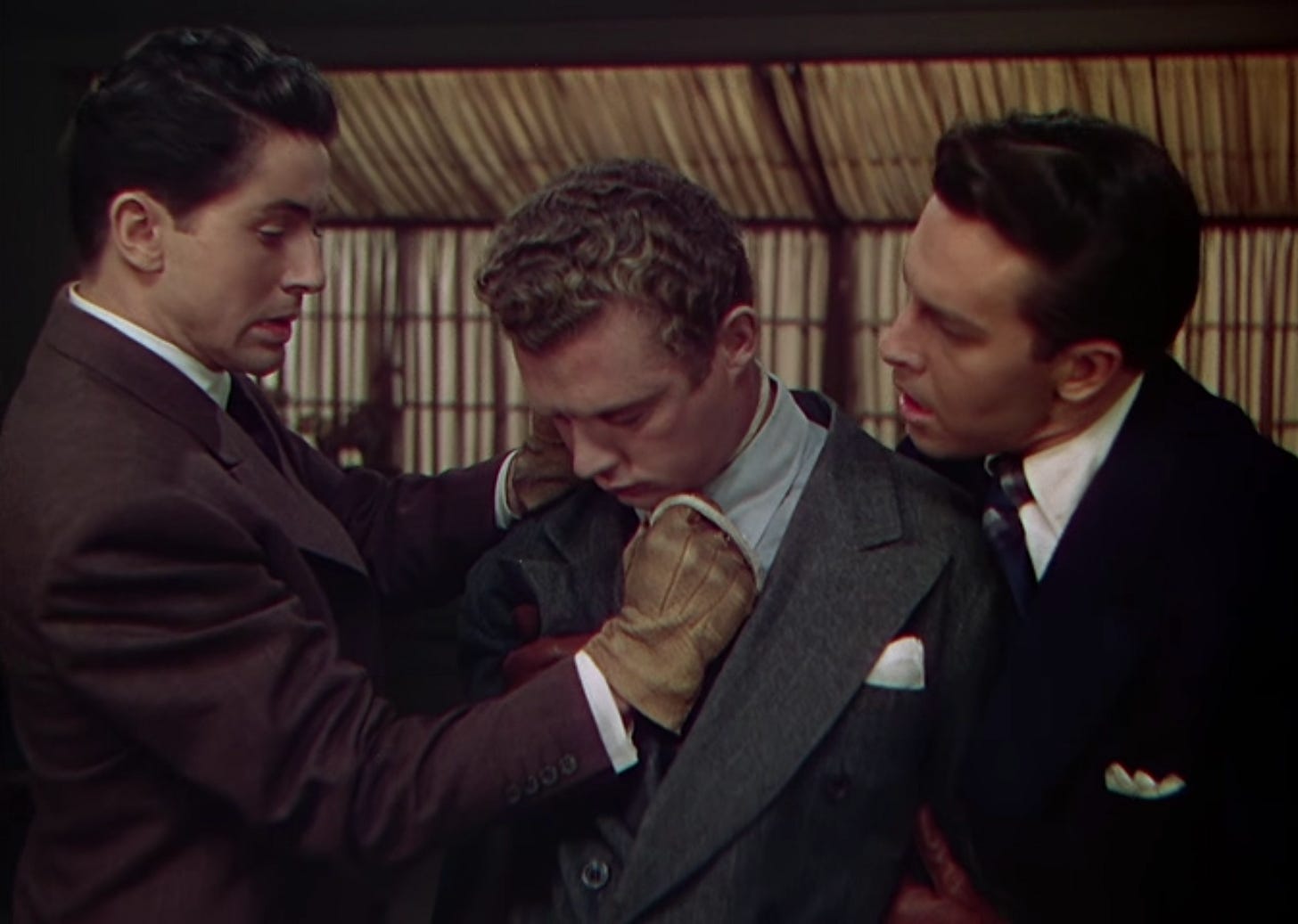Alfred Hitchcock's First Color Film Is Also Not-So-Secretly A Gay Classic
"Out of character for him to be murdered, too."
Farley Granger, Dick Hogan, John Dall, Rope, Warner Bros.
NOTE: This essay was originally meant to appear as a part of Slashfilm’s “Movies Are Gay” Pride month series, which was canceled one week into what was planned as a month-long run, though you can read a new list version of the series here. The version that appears here has been edited slightly since there is no longer a word count constraint.
At a time when misinformation has degraded America’s sense of cultural history and politicians are trying very hard to convince their supporters that queer and trans people are somehow a new phenomenon, I was especially excited to highlight a movie featuring several gay characters and actors that was made over 70 years ago. You can rent Rope on YouTube, Apple TV, or Amazon for $3.99.
One of Alfred Hitchcock’s most formally experimental films is also one of his gayest. The 1948 thriller “Rope” is a movie that unfolds in real-time, slowly and deliberately tightening its grip on audiences like the titular murder weapon itself. The master of suspense – by this point already fascinated with queer subtext, which also drenches his 1940 adaptation of Daphne du Maurier’s “Rebecca” – here turns his gaze to the Leopold and Loeb case, a real-life murder that shocked the nation in 1924.
The true story of Nathan Leopold and Richard Loeb was stranger than fiction; the pair of privileged college students were fixated on the idea of proving themselves as intellectually superior Ubermensch by committing the perfect crime, and ultimately carried out the murder of a 14-year-old boy. Their plan crumbled, and the two men eventually both confessed, turning on one another in custody. Leopold and Loeb were also in a gay relationship, which was apparent in Patrick Hamilton’s play version of “Rope” and only ever-so-slightly masked in Hitchcock’s Hayes Code-dodging screen adaptation.
“Rope” takes place over the course of one evening, as two young intellectuals – dominant, thrill-seeking Brandon (John Dall) and guilt-stricken Phillip (Farley Granger) – host a dinner party with the body of their victim housed in a chest in the next room. Throughout the night, Brandon grows more daring in his allusions to the crime, while Phillip grows more inconsolable. Among their guests is Rupert Cadell (James Stewart), a professor who introduced the men to the Nietzschean ideas that inspired their foray into murder.
As Hitchcock’s first Technicolor movie, “Rope” is a stunner in more ways than one. The filmmaker is clearly entering his prime here, and just as Phillip and Brandon attempt a near-impossible feat, so, too, does the director; he famously built the movie with a series of 10 long takes and masked many of his cuts to give the illusion of a continuous shot. The method gives the film a sense of gorgeously elliptical near-claustrophobia, keeping viewers close to both the action and the impending breakdown of the two killers.
It’s not just the cameras that get close; Dall and Granger make their characters’ relationship clear through visual subtext, often standing inches from one another’s faces as Phillip and Brandon share an indecent, unspoken thrill. Like several of Hitchcock’s queer films, “Rope” features a morally questionable take on homosexuality; the men on screen can’t talk about their most obvious shared secret, but they can talk about murder – which is by no means an accurate or flattering stand-in for queerness.
Still, “Rope” is a formative early installment in the “bad gays” canon, a movie that crafts memorably evil characters who are emblematic of a time period when intellectualism, aesthetics, and homosexuality all threatened the status quo. Granger, a bisexual actor, is excellent as the more submissive half of the criminal duo, while Dall (who was likely gay but never officially came out) is devilishly captivating as his more impulsive counterpart. Screenwriter Arthur Laurents did come out, though, and said in his memoir, “Original Story By,” that “there wasn’t a word of dialogue that said the lovers [in “Rope”] were lovers or homosexual, but there wasn’t a scene between them where it wasn’t clearly implied.”
While “Rope” is remembered as a complex, stylish portrait of villainy, it should also be celebrated for its thematic audacity: it’s a Hollywood movie made by and about gay men at a time when the walls of the celluloid closet were still decades away from coming down.





Woah! This sounds so good. I'm def gonna suggest watching this to my two best movie watching friends in B'ham.
Loooove this! I've never seen Rope, since I don't typically reach for a scary movie but I forget that Hitchcock is less in your face scary and more brilliantly executed tension. I think I'll suggest to Jan that we watch this one together some evening. Very glad to see this piece posted.